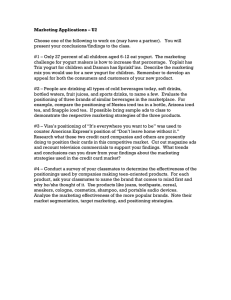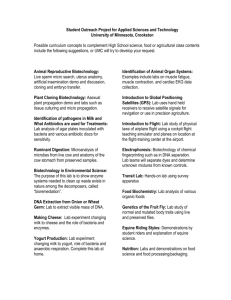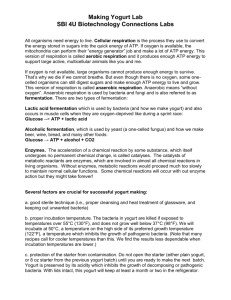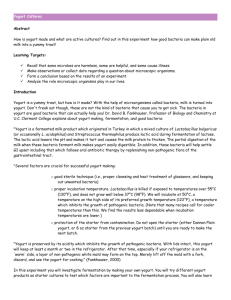Roger Merkel, Ph.D. Langston University American Institute for Goat
advertisement
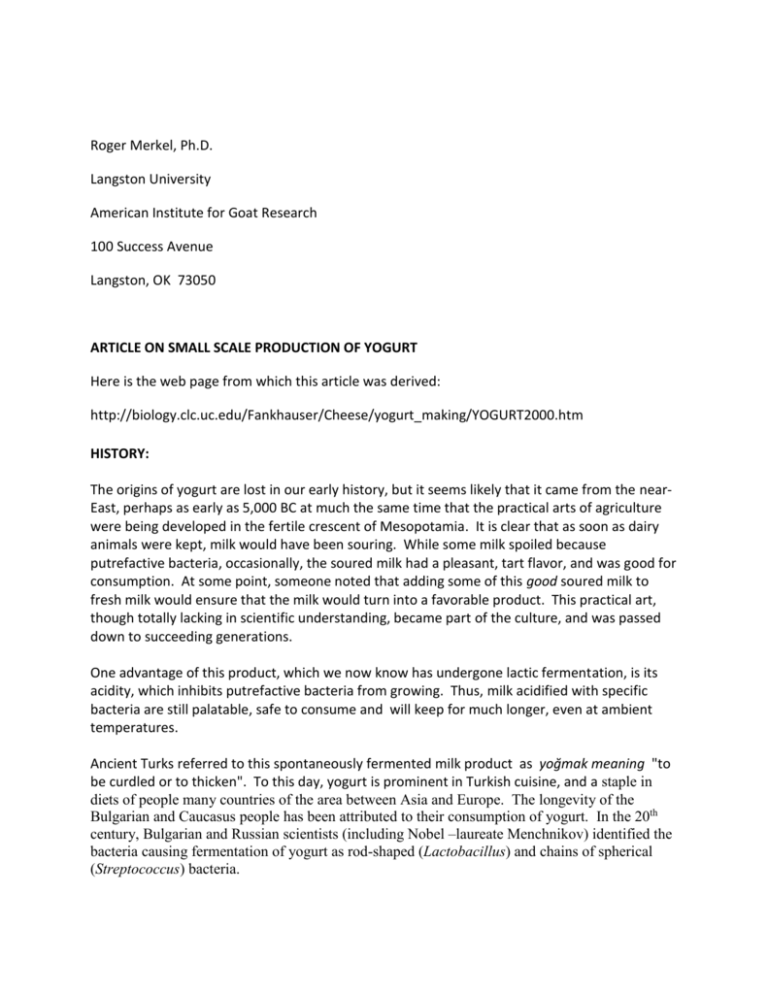
Roger Merkel, Ph.D. Langston University American Institute for Goat Research 100 Success Avenue Langston, OK 73050 ARTICLE ON SMALL SCALE PRODUCTION OF YOGURT Here is the web page from which this article was derived: http://biology.clc.uc.edu/Fankhauser/Cheese/yogurt_making/YOGURT2000.htm HISTORY: The origins of yogurt are lost in our early history, but it seems likely that it came from the nearEast, perhaps as early as 5,000 BC at much the same time that the practical arts of agriculture were being developed in the fertile crescent of Mesopotamia. It is clear that as soon as dairy animals were kept, milk would have been souring. While some milk spoiled because putrefactive bacteria, occasionally, the soured milk had a pleasant, tart flavor, and was good for consumption. At some point, someone noted that adding some of this good soured milk to fresh milk would ensure that the milk would turn into a favorable product. This practical art, though totally lacking in scientific understanding, became part of the culture, and was passed down to succeeding generations. One advantage of this product, which we now know has undergone lactic fermentation, is its acidity, which inhibits putrefactive bacteria from growing. Thus, milk acidified with specific bacteria are still palatable, safe to consume and will keep for much longer, even at ambient temperatures. Ancient Turks referred to this spontaneously fermented milk product as yoğmak meaning "to be curdled or to thicken". To this day, yogurt is prominent in Turkish cuisine, and a staple in diets of people many countries of the area between Asia and Europe. The longevity of the Bulgarian and Caucasus people has been attributed to their consumption of yogurt. In the 20th century, Bulgarian and Russian scientists (including Nobel –laureate Menchnikov) identified the bacteria causing fermentation of yogurt as rod-shaped (Lactobacillus) and chains of spherical (Streptococcus) bacteria. WHAT STARTING PRODUCT CAN BE USED TO MAKE YOGURT? Yogurt can be fermented from any kind of milk, as well as a number of vegetable “milks.” All that is necessary is a sugar which can be fermented which these bacteria can produce into lactic acid. A major key to success is to ensure that the only bacteria present in the warmed scalded milk are the beneficial “lactic acid” bacteria. The acidification results in a healthful, thickened, acidic food that will stay fresh longer than milk itself, and that contains millions of bacteria that are welcomed by the human gut. Yogurt has gained considerable popularity in America in recent decades, in keeping with general trends toward organic, cultured, and nutrient-dense foods. Yogurt can be mildly tart or quite sour, and can be anywhere between thin enough to pour to thick enough to stand up on a plate. Yogurt contains the protein and calcium of milk as well as a variety of vitamins. Additionally, since the process of yogurt fermentation is similar to the process of digestion, yogurt can be easily digested. NUTRITIONAL CONTENT Not only does yogurt contain the same amount of protein and fat as the milk from which it is made, it also contains calcium, riboflavin, vitamin B6, and vitamin B12. Because it is easily digested, it offers nutrition to individuals who may have digestive problems or malabsorbtion syndromes of a variety of descriptions. OUTLINE OF THE PRINCIPLE STEPS IN MAKING YOGURT: Here are the several simple principles of making good yogurt: 1) Good quality milk is scalded (95 C) to kill any pathogens of putrefactive bacteria. 2) The milk is cooled to 55 C. 3) Bacterial starter, containing live lactic acid bacteria, usually yogurt from a previous batch, is added at the ratio of 1 part yogurt to 16 parts scalded and cooled milk. 4) The inoculated milk is poured into sterilized jars, covered, and incubated at 50 C for 3 hours, or more if greater tartness is desired. 5) The jars are chilled, and kept under refrigeration until desired. Properly made yogurt will easily keep a month or more. TURNNING ONE GALLON (FOUR LITERS) OF MILK INTO YOGURT: EQUIPMENT: Heat source: we prefer gas because of heat distribution, but electric or other source will suffice. Large ~five gallon pot (= 20 liter) with lid Seven Mason jars, plus a 16 ounce jar for the next starter Eight Lids Eight Rims Tongs Two cup (500 mL) measure whisk MATERIALS: One gallon of fresh wholesome milk 8 ounces of fresh unalduterated yogurt (or starter purchased from a supplier) I: STERILIZE JARS AND EQUIPMENT TO BE USED: 1) Proper sanitization is important at every stage of making yogurt. To start, the containers in which the yogurt will be made must be sanitized. To do this, place about an inch of water in the bottom of a large pot (a canner is being used here). Place all equipment to be sterilized in the pot : a) Mason jars b) Lids c) Rims d) Tongs e) Two cup (500 mL) measure f) Canning funnel. 2) Cover the pot and bring to a boil so that you see steam coming out from under the lid. Boil for 10 minutes. 3) Spread a clean cloth (here a dish towel), and unload the sterilized equipment from the sterilizing pot. II. SCALD AND COOL THE MILK. 1) Meanwhile, select a 1.5 to 2 gallon stainless steel pot which features a thick aluminum pad on the bottom to disperse the heat and prevent burning. (Alternatively, set up a double boiler with a larger pot mostly filled with water into which the pot containing the milk is placed. Have a lid which covers the whole assembly.) 2) Add one gallon of fresh milk to the pot. You may just about any milk: 3.5 %, 2% or skimmed milk. More butterfat produces a richer flavored yogurt. (Reconstituted powdered milk does not work well because the yogurt is very thin and tasteless.) 3) Cover the pot and heat slowly to 85 C (185 F). The first time you make it, monitor the milk to be sure it is not burning or sticking to the bottom. If it sticks, turn down the heat and/or stir more often. If in doubt, the safest heating means is to use a double boiler as described above). With the pot shown, we are able to have the flame on medium high with no problems and reach 85 C in about 25-30 minutes. 4) Run a clean dish pan half full of cold, clean tap water. Carefully lower the covered 85 C milk into the dish pan to cool. (Do not splash the cooling water into the scalded milk.) 5) Insert a thermometer into the milk to monitor the temperature. Closely watch the temperature as the milk cools. You want a cooled temperature of 55 C, (no lower than 50 C). Stir when the temperature drops to 55 C (130 F). Once the milk is uniformly at or below 55 C, remove from the cold water bath to the counter. III. INOCULATE THE SCALDED AND COOLED MILK WITH BACTERIAL STARTER 1) For a yogurt starter, either purchase pure starter from a dealer, or purchase the freshest pure yogurt at the store (with the expiration date farthest into the future). It should contain only cultured milk and live bacteria. (No fruit, pectin, guar gum or other additives). “Dannon Plain” has worked well for years. A) Place 1 cup of scalded and cooled milk in the sterilized two cup measure. B) Add enough commercial yogurt to q.s. ( fill) the two cup measure to the two cup level. C) Blend the two cup contents thoroughly with a whisk. 2) Add the blended yogurt-milk starter to the scalded and cooled milk (it should still be between 50 and 55 C) with stirring to mix thoroughly. 3) Fill the sterilized jars with the 50-55 Cinoculated milk, using the sterilized funnel if necessary. Immediately cover as soon as the jar is filled. 4) Alternately, with practice, one can pour the milk directly from the pot into the sterilized jars. Again, cover immediately with sterilized lids. IV) INCUBATE THE INOCULATED MILK AT 50 C 1) Heat about a gallon and a half of water to 55 C. (Part of the water can be the water used to cool the scalded milk). Situate a “cooler” (Styrofoam, “Playmate”, etc) where it can sit undisturbed for the length of the incubation. 2) Place the jars of inoculated milk into the cooler, and fill with the55 C water up to the shoulders of the jars. (Do not over fill which could contaminate the lids with the water). Check the temperature. It should now be around 50 C (up to 55 C). Close the “cooler” and do not disturb for around three hours. After three hours, check for gelling by gently shaking. If suitably gelled, label each jar with the date and place in the refrigerator. IV. REFRIGERATE FINISHED YOGURT FOR LONG TERM STORAGE 1) Yogurt made at home is delicate and mild. If you want it more tart, incubate longer. If you want it thicker, you may dissolve a tablespoon (15 cc) of powdered milk per quart (liter) in the milk before scalding. Alternatively, you could make “Greek yogurt” (see below). 2) If the properly made yogurt is refrigerated at 4 C, it will easily keep for a month or longer. V. MAKING “GREEK YOGURT” 1) “Greek yogurt” is all the rage these days. It is merely yogurt which has been partially drained. To make a thicker yogurt, referred to as “Greek yogurt”: A) Line a strainer or colander with a sterile cloth (a handkerchief sterilized by boiling works great). Stir your yogurt well, and transfer it into the cloth. (You may save the original jar to hold the finished “Greek” yogurt.) B) Pick up the four corners of the handkerchief. C) Suspend with a thick rubber band looped around the ends as shown, and hang to drain for one to three hours (or more?), depending on how thick you like your Greek yogurt. Transfer the drained yogurt back into the jar and store in the refrigerator. If you add a teaspoon of salt/quart first, and drain it overnight, you have made labneh, a favorite Lebanese soft cheese. Here is the webpage describing how to make labneh and how to serve it: http://biology.clc.uc.edu/Fankhauser/Cheese/Making_Laban/Labneh.htm EPILOGUE: The production of yogurt, while involving a number of steps which require careful attention, becomes simple as you understand the reason behind each step. Of course, rigorous attention to each step is necessary so that the quality of the final product is ensured. USES OF YOGURT? You may want to explore the numerous recipes which use yogurt as a central ingredient, especially in the middle and near east. The tart and healthful contribution to these dishes is wonderful. Finally, in recent years, we have seen increasing advertising campaigns which promote the health benefits of “probiotic” bacteria in yogurt. We look forward to additional evidence of the health benefits to consumption of yogurt.


